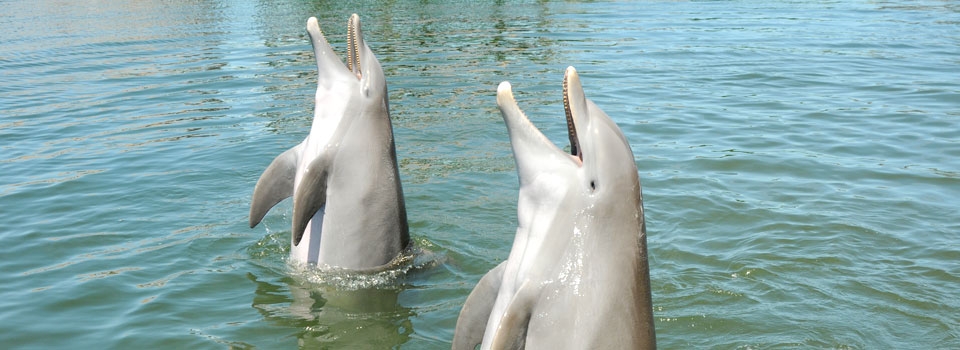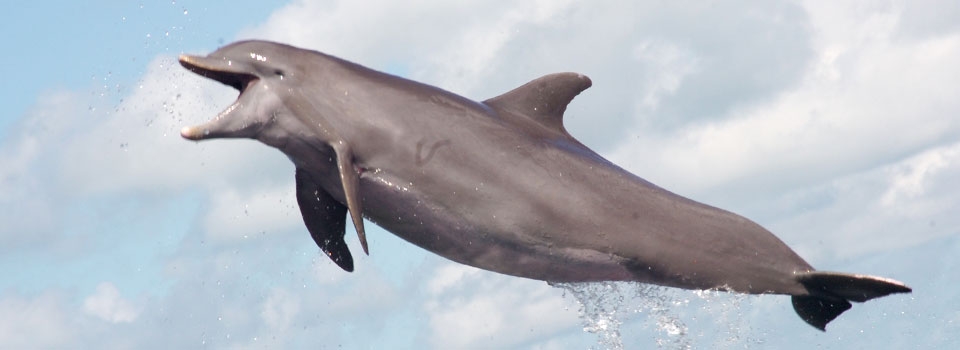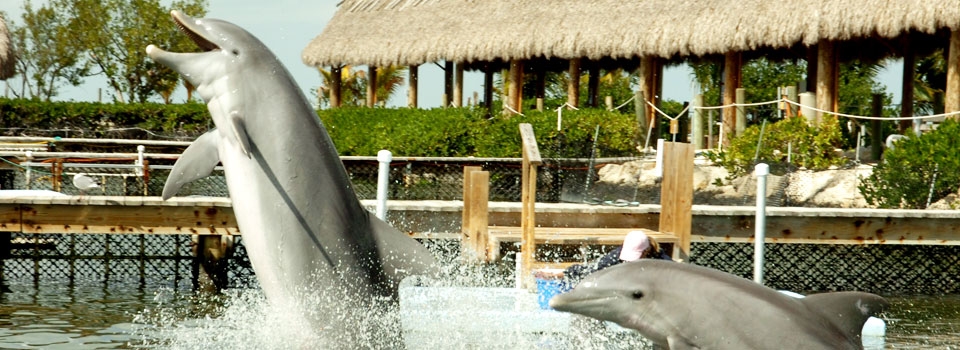News to Share
Research Shows Dolphins Get 40s Flab Too
16 August 2021
FOR IMMEDIATE RELEASE
Media Contact: Mary Stella, Director of Media & Marketing
305-289-1121, ext. 254
Email: media@dolphins.org
Contact: Robin Ann Smith
Duke University
(919) 681-8057
ras10@duke.edu
Dolphins Get 40s Flab, Too
Humans aren’t the only species whose metabolisms tend to slow down with age
DURHAM, N.C.; Grassy Key, FL -- If you feel like your metabolism just isn’t what it used to be, no matter how many hours you spend in the gym, dolphins can relate. A Duke University-led study finds that bottlenose dolphins burn calories at a lower rate as they get older, just like we do. Marine mammal facilities Dolphin Research Center, Grassy Key, FL, and Dolphin Quest, HI, collaborated on this research.
It’s the first time scientists have measured an age-related metabolic slowdown in another large-bodied species besides humans, said first author Rebecca Rimbach, postdoctoral associate in evolutionary anthropology at Duke. Rimbach has studied energy expenditure and other aspects of physiology in animals ranging from mice to monkeys. But data on the inner workings of marine mammals such as dolphins and whales have been scant, she says. That’s because these ocean giants are notoriously difficult to recapture for repeat measurements. “It can be very tricky to get the animal back when you need it,” Rimbach said.
The researchers studied 10 bottlenose dolphins aged 10 to 45 living at Dolphin Research Center and Dolphin Quest. To measure their average daily metabolic rate, the researchers used the “doubly labeled water method.” Used to measure energy expenditure in humans since the 1980s, it’s a method that involves getting the animals to drink a few ounces of water with naturally occurring “heavy” forms of hydrogen and oxygen added, and then tracking how long the animals take to flush them out.
“The dolphins already cooperate in their own health care and are accustomed to receiving water through a tube down their throats to their stomachs. They don’t have a gag reflex, and this process is comfortable and commonplace to them,” explained Emily Guarino, Director of Research Training and Data Collection for Dolphin Research Center. “They voluntarily give blood, urine, and other samples,” Guarino continued. Like humans present their arms for a blood draw, the dolphins allow themselves to be positioned in the water so that their caregivers can collect samples as part of their regular checkups.
By analyzing the levels of heavy hydrogen and oxygen atoms in the blood or urine, the team was able to calculate how much carbon dioxide the dolphins produced each day, and thus how many calories they were burning as they went about their lives. What they found surprised them. The researchers expected dolphins to have revved-up metabolisms, since dolphins are warm-blooded just like people, and keeping warm requires more energy in water than in air. But despite living in a watery world, they found that bottlenose dolphins burn 17% less energy per day than expected for a marine mammal of their size.
The scientists also noted some of the same signs of metabolic aging common in people. The oldest dolphins in the study, both in their 40s, used 22% to 49% fewer calories each day than expected for their body weight. And similar to humans, more of those calories ended up as fat rather than muscle. Dolphins in their 40s had body fat percentages that were 2.5 times higher than their under-20 counterparts.
It wasn’t for lack of exercise, Rimbach said. Dolphins are amazing athletes, capable of leaping 10 feet into the air and swimming alongside power boats at speeds that would crush Michael Phelps. The dolphins in the study were observed doing flips and spins, walking on their tails, jumping clear out of the water and going fast enough to leave a wake as often as six to 18 times an hour, and they remained active into their 40s. But the pattern remained no matter what their activity level.
“And it’s not because they’re eating too much either,” Rimbach said. The researchers recorded how much herring and other fish the dolphins gobbled up, and they found that the older, fatter dolphins in the study actually ate fewer calories.
The researchers say such work could shed light on factors besides diet and lifestyle that underlie age-related weight gain in people. “Further studies into this commonality we share with dolphins may help us understand why human metabolism slows as we age,” said co-author Hannah Salomons, a graduate student in professor Brian Hare’s lab at Duke.
“Having access to healthy dolphins under human care made this study possible,” said co-author Austin Allen of the Duke University Marine Lab.
“We need more data, especially for younger dolphins, since we only looked at 10 individuals,” Rimbach said. “But I think it's an exciting first study.”
This work was supported by Duke University and an International Marine Animal Trainers’ Association (IMATA) Research Grant.
CITATION: "Total Energy Expenditure of Bottlenose Dolphins (Tursiops truncatus) of Different Ages," Rebecca Rimbach, Ahmad Amireh, Austin Allen, Brian Hare, Emily Guarino, Chana Kaufman, Hannah Salomons, Herman Pontzer. Journal of Experimental Biology, Aug. 5, 2021. DOI: 10.1242/jeb.242218
# # #
Note to editors: Contact Robin Smith at ras10@duke.edu or Emily Guarino at research@dolphins.org for a copy of this study. First/ corresponding author Rebecca Rimbach can be reached at rrimbach@gmail.com.###
Dolphin Research Center Training Institute Graduates New Class
05 May 2021
FOR IMMEDIATE RELEASE
Media Contact: Mary Stella, Director of Media & Marketing
305-289-1121, ext. 254
Email: media@dolphins.org
Dolphin Research Center Training Institute Graduates Class of 2021
Grassy Key… Three exemplary students have completed 36 weeks of intensive study and hands-on work and earned Occupational Associates degrees in Marine Mammal Behavior, Care, & Training from Dolphin Research Center Training Institute (DRCTI). The experience and knowledge they received prepares them to work at marine mammal facilities or other zoological institutions anywhere in the world.
The Class of 2021’s graduates are: Bianca Cheung, Josie Koren, and Jessica Massie. All three of the alumni have also been hired by Dolphin Research Center. Koren has joined the Animal Care & Habitat department; Cheung and Massie will work as seasonal staff in Animal Care & Training.
“We could not be prouder of the graduates and the phenomenal effort they devoted to their program over the last several months. They truly earned their degrees and will be outstanding marine mammal trainers and caregivers wherever they work,” said Noelle Belden, Dean of DRCTI.
Dolphin Research Center Training Institute is accredited by the Accrediting Commission of Career Schools and Colleges (ACCSC) #M072566 and Licensed by the State of Florida Commission for Independent Education (CIE) #4766. Founded in 2012 and originally called College of Marine Mammal Professions,
DRCTI is a highly selective program and only enrolls a small number of students for each school term which runs from early September to mid-May. The majority of previous graduates are working in animal care and training or related fields around the country.
Students for the 2021-2022 school term have already been selected. The application period for 2022-2023 opens September 1st. More information, including prerequisites, curriculum, and costs, can be found at www.dolphininstitute.edu, or by calling 305-289-1121, ext. 215.
###
For Dolphins, "Talking" Helps Teamwork
18 March 2021
FOR IMMEDIATE RELEASE
Media Contact: Mary Stella, Director of Media & Marketing
305-289-1121, ext. 254
Email: media@dolphins.org
For Dolphins, "Talking" Helps the Teamwork
Grassy Key… Whether in the open oceans or in a marine mammal facility, dolphins are often seen teaming up for various activities. A new study from researchers at Dolphin Research Center (DRC) in the Florida Keys and the University of Bristol in the United Kingdom, shows that when dolphins communicate vocally with each other, they cooperate better. "Talking" helps their teamwork.
“We knew from our previous cooperation study that the dolphins could coordinate precisely, so now we wanted to look at how they did it,” said Dr. Kelly Jaakkola, Director of Research for Dolphin Research Center.
To explore this question, the researchers created a task where pairs of DRC bottlenose dolphins had to swim across a lagoon and press their own underwater buttons within one second of each other. To make things even more difficult, sometimes the dolphins were sent to their buttons at different times, and sometimes the buttons were positioned so the dolphins couldn’t see each other. Underwater microphones (hydrophones) recorded the dolphins’ communication during each trial. “If you and I wanted to do something at the same time, we would probably coordinate verbally - like ‘one, two, three, go’. The question here was whether the dolphins would also use vocal communication to coordinate,” Jaakkola added.
The results showed that communication mattered. The dolphin pairs accomplished their tasks with high rates of success, coordinating most precisely when they whistled to each other. The timing of their communication was also important, as shown by the fact that they were more likely to succeed if they pushed their buttons after the last whistle.
This study furthers understanding of the role that communication plays in facilitating cooperation in animal societies. Dr. Stephanie King from the University of Bristol noted that, “The data show that some dolphins can use vocal communication to actively coordinate their cooperative behavior.” In field studies conducted in Shark Bay, Australia, King and her colleagues observe that, “Bottlenose dolphins cooperate extensively in the wild. Experimental studies like this one provide key insight into how they do it.”
The study is published in Royal Society Open Science, 8, 202073, a research journal of The Royal Society, a Fellowship of the world’s most prominent scientists and the oldest scientific academy in continuous existence. It was supported by a grant from Jim and Marjorie Sanger to Dolphin Research Center; Dr. King was supported by The Branco Weiss Fellowship-Society in Science.
Read the full text of the study at: https://royalsocietypublishing.org/doi/10.1098/rsos.202073 View a video about the study at https://youtu.be/6aX9dHiPQI0
Founded in 1984, Dolphin Research Center is a nonprofit organization, and home to bottlenose dolphins and California sea lions. Located at 58901 (mile marker 59) Overseas Highway, Grassy Key, Florida, the center is open daily for the public to see narrated behavior sessions and educational presentations, and to participate in interactive programs. The center is funded by admission and program fees as well as by private donors and members. In addition to being one of the most highly respected education and research facilities in the world, DRC is an accredited member of the Alliance of Marine Mammal Parks and Aquariums and the International Marine Animal Trainers Association. For more information, visit www.dolphins.org.
Citation: King, S.L., Guarino, E., Donegan, K., McMullen, C., & Jaakkola, K. (2021) Evidence that bottlenose dolphins can communicate with vocal signals to solve a cooperative task. Royal Society Open Science, 8, 202073.
###
Dolphins Understand Their Partner's Role in a Cooperative Task
01 May 2019
A new study from researchers at Dolphin Research Center in the Florida Keys and The University of Western Australia shows that bottlenose dolphins not only cooperate with each other, but can do so with precise behavioral coordination never before demonstrated in nonhuman animals. Dr. Kelly Jaakkola of the Dolphin Research Center noted that behaviors that look like cooperation in the wild do not necessarily mean that animals understand cooperation. “Cooperative behaviors are actually found throughout the animal kingdom,” Dr. Jaakkola said. “From small birds collectively dive-bombing a predator to drive it away, to ants teaming up to carry a large piece of food. That’s not new. But the question is how they’re doing it. Are they simply acting individually in the same place and time, or do they actually understand that they need their partner, and actively coordinate with them?”
To get at this issue of understanding, the researchers created a task in which pairs of dolphins had to swim across a lagoon and each press their own underwater button simultaneously (within a 1-second time window), whether sent together or with a delay between partners of up to 20 seconds. “The question was whether the dolphin sent first would wait for the other dolphin before pressing its button,” Dr. Jaakkola said, “and whether they could figure out a way to coordinate precisely enough to press at the same time.”
The results of the study showed that the dolphins not only waited for their partner, but also succeeded at the task with extreme precision, with the time between button presses in the latter trials averaging just 370 milliseconds. This shows that bottlenose dolphins understand how cooperation works, and suggests that the behavioral synchronization they show in the wild may in fact be a generalized cognitive ability that they can apply to a variety of situations.
In previous studies, animals’ understanding of cooperation has been explored primarily with a task in which two animals must pull the ends of a rope in the same direction to receive a food reward. However, the less stringent timing requirement of that task creates a window of opportunity in which the animals could theoretically succeed by using a simpler behavioral strategy (e.g., “Pull when a partner is there”), rather than by jointly intended coordination. The tight timing requirement of the button press study closes that window.
Dr. Stephanie King, from UWA Centre for Evolutionary Biology, noted that the dolphins’ precise coordination task was inspired by wild dolphin behavior. Dr King said that “the behavioural synchrony we observe in wild dolphins can be remarkably precise, for example, the synchrony we observe in the coordinated displays of allied male dolphins is thought to actively promote cooperation. We wanted to test whether this was a skill they could apply to novel contexts.”
“The next step will be to investigate whether dolphins use vocal signals to coordinate behaviour during cooperative situations,” Dr King said. “This will further our understanding of the role that communication plays in facilitating cooperation in animal societies.”
The study is published in the journal Proceedings of the Royal Society B, and supported by grants from Jim and Marjorie Sanger and The Branco Weiss Fellowship.
MEDIA REFERENCE:
Dr. Kelly Jaakkola kelly@dolphins.org
Dr. Stephanie King stephanie.king@uwa.edu.au
Mary Stella (DRC Director of Media & Marketing) +1 305 289 1121 x254 media@dolphins.org
ARTICLE:
Jaakkola K, Guarino E, Donegan K, King SL. 2018 Bottlenose dolphins can understand their partner’s role in a cooperative task. Proc. R. Soc. B 20180948. http://dx.doi.org/10.1098/rspb.2018.0948
How Long Do Dolphins Live?
01 May 2019
FOR IMMEDIATE RELEASE
Media Contact: Mary Stella, Director of Media & Marketing
305-289-1121, ext. 254
Email: media@dolphins.org
Research Study Reveals Dolphins in U.S. Aquariums and Zoos Live As Long As or Longer Than Dolphins in the Wild
Grassy Key… Bottlenose dolphins living in United States marine mammal facilities live as long as, or longer than, dolphins in the wild according to a new research study published today in the journal Marine Mammal Science. (K. Jaakkola/K. Willis: How long do dolphins live? Survival rates and life expectancies for bottlenose dolphins in zoological facilities vs. wild populations. Marine Mammal Science 2019; DOI: 10.1111/mms.12601.) Analyzing close to 40 years of data from a U.S. government source called the Marine Mammal Inventory Report (MMIR), researchers determined that the current median life expectancy of bottlenose dolphins in U.S. facilities is 29.2 years. The study also compared the MMIR data with previous studies of three different wild populations of dolphins. In each comparison, the average life expectancy of dolphins in facilities was shown to be equal to or greater than that of dolphins in the wild.
Dr. Kelly Jaakkola of Dolphin Research Center, and Kevin Willis of The Minnesota Zoo, co-authored the peer-reviewed study. “Survival rates and life expectancies are indicators of overall health and well-being,” explained Dr. Jaakkola. “Critics of zoos and aquariums will frequently claim that dolphins in facilities don’t live as long as dolphins in the wild, in an attempt to influence public opinion and even proposed legislation. This study shows that that claim is just not true.”
To determine the median life expectancy of dolphins in U.S. facilities, Jaakkola and Willis divided the MMIR data into four time periods of about ten years each, and applied the Kaplan-Meier Survival Analysis to the data. This enabled them to calculate annual survival rate and median life expectancy over historical time. Life expectancy is the average number of years that animals in a population are expected to live, while life span identifies the maximum number of years that animals in a population can live. “In humans, for example, the maximum lifespan so far is about 122 years, whereas average life expectancy worldwide is about 72 years,” said Jaakkola.
The last scientific paper to analyze survival of dolphins in marine mammal facilities used data that are now more than 25 years old. “Even back then, their life expectancy was increasing,” Jaakkola continued. “We thought it was important to do a new study to update those results – to see if dolphin life expectancy had continued to increase, and to compare the results to wild populations.”
For complete data sets like the MMIR, a survival analysis like the Kaplan-Meier is the best mathematical approach. Unfortunately, due to the more limited observations inherent in studies of wild populations, no wild study to date has been able to use this type of analysis. Instead, previous studies used different analyses to study the wild dolphin populations of three different areas: the Indian River Lagoon System, FL (1978-1997); Mississippi Sound Region (1986-2003); Sarasota Bay, FL (1980-1987). For an accurate comparison to these studies, the Jaakkola/Willis study used the same analysis method on the MMIR data that was used for each of the different wild populations. In every case, the median life expectancy of dolphins living in U.S. facilities today was found to be as long or longer than their wild counterparts.
Article text is available with open access at: http://doi.wiley.com/10.1111/mms.12601
Founded in 1984, Dolphin Research Center is a nonprofit organization, and home to bottlenose dolphins and California sea lions. Located at 58901 (mile marker 59) Overseas Highway, Grassy Key, Florida, the center is open daily for the public to see narrated behavior sessions and educational presentations, and to participate in interactive programs. The center is funded by admission and program fees as well as by private donors and members. In addition to being one of the most highly respected education and research facilities in the world, DRC is an accredited member of the Alliance of Marine Mammal Parks and Aquariums and the International Marine Animal Trainers Association. For more information, visit www.dolphins.org.
###
DRC Research Shows Dolphin Moms Use Signature Whistles to Reunite with Calves
19 May 2016
Grassy Key… Dolphin Research Center (DRC), a not-for-profit research and education facility in the Florida Keys, has announced the publication of two research studies, each of which reveals fascinating information about how bottlenose dolphin mothers use their signature whistles to communicate with their calves. Each bottlenose dolphin has a unique signature whistle that help them to recognize each other. Because dolphin babies are mobile immediately after birth and separations can occur, mother-offspring recognition is particularly important.
The study titled Further Insights into Postpartum Signature Whistle Use in Bottlenose Dolphins (Tursiops truncatus), published in the journal Marine Mammal Science, showed that new dolphin mothers produce their signature whistle at much higher rates immediately after their calves are born, and continue to do so for up to a month. This increase helps the calf recognize its mother and allows mothers and calves to reunite if they become separated. It is the first study of its kind to be conducted with female calves and supports the theory that the increased use of vocal signatures in the post-partum period serves to imprint the mother’s whistle on her baby. For the study, researchers used arrays of hydrophones (underwater microphones) and recorded the vocalizations of two female dolphins at Dolphin Research Center, Pandora and Calusa. Recordings were made for 12 weeks total, five weeks before the dolphins gave birth and then seven weeks after each delivered her baby.
In the study Maternal Signature Whistle Use Aids Mother-Calf Reunions in a Bottlenose Dolphin, Tursiops truncatus, published in the journal Behavioral Processes, a mother dolphin used her signature whistle when asked to retrieve her baby, but not when asked to retrieve inanimate objects. This shows that signature whistles not only are used by dolphins to broadcast their individual identities, but that maternal signature whistle use is important to facilitate mother-calf reunions. Merina, an adult female, and her young daughter Windley participated in the study. In the experimental trials, researchers installed hydrophones in the natural lagoon where Merina and Windley lived. When Merina was given the verbal and hand signals to “Go get the baby”, she produced her signature whistle, which researchers were able to record. Unlike previous studies, this was the first to use controls, which means that Merina was sometimes asked to retrieve a random object, such as a toy, that had been placed in her lagoon. On those trials, she did not produce her vocal signature. This further demonstrated that the she used her signature whistle only to call her baby.
For both of these studies, DRC’s research team, led by Dr. Kelly Jaakkola, collaborated with Dr. Stephanie King, Research Fellow at Western Australia University, who is known for her acoustics work with dolphins both in the wild and in human care.
Founded in 1984, Dolphin Research Center is the forever home to a family of bottlenose dolphins and California sea lions. Located at 58901 (mile marker 59) Overseas Highway, Grassy Key, Florida, the center is open daily for the public to see narrated behavior sessions and educational presentations, and to participate in interactive programs. The nonprofit organization is funded by admission and program fees as well as by private donors and members. In addition to being one of the most highly respected education and research facilities in the world, DRC is the Licensed Manatee Rescue Team for the Florida Keys and is an accredited member of the Alliance of Marine Mammal Parks and Aquariums and the International Marine Animal Trainers Association. For more information, visit www.dolphins.org.
DRC Research Video Voted Winner in International Student Challenge
03 April 2015
Grassy Key, FL… Middle school students in more than 1600 classrooms and 21 countries recently selected Dolphin Research Center (DRC) as a first place winner in the 2015 Ocean 180 Video Challenge for its Blindfolded Imitation research study. Almost 38,000 student judges evaluated 10 finalists based on their creativity, message and educational value and ultimately determined which three-minute video abstracts best explained the results and significance of the scientists’ research. The Blindfolded Imitation research revealed that bottlenose dolphins can imitate actions without using their eyesight. Besides humans, dolphins are the only species that have so far demonstrated this ability. In addition to a trophy, the non-profit marine mammal research and education facility will also receive a $3,000 prize to honor its work in communicating science to the public. One Florida Keys school, Treasure Village Montessori, Islamorada, was among the 336 schools that cast ballots.
DRC participated in the Ocean 180 Challenge to further advance their mission of teaching, learning and caring about marine mammals and the environment. “We’re excited that the students awarded us first place. But we felt like we won in the most important way when we became a finalist, and tens of thousands of kids watched the videos in the judging process, and got to learn about dolphin research,” said DRC Co-Founder and Chief Operating Officer Mandy Rodriguez.
The challenge also provided a way to reach the next generation of ocean scientists. As Director of Research Dr. Kelly Jaakkola explained, “For a lot of students, science can have a negative, scary image. They picture people in white lab coats talking about topics that nobody understands in the most boring, unimaginative way possible. If we want to get kids excited about science, we need to change that image.”
Dolphin Research Center’s video was created by the center’s Research, Media and Visual Communications staff which placed it in the category designated for videos produced with professional assistance. All of the finalists in the 2015 challenge can be viewed online at http://ocean180.org. The Ocean 180 Video Challenge, sponsored by the Florida Center for Ocean Science Education Excellence (COSEE Florida) and funded through a grant from the National Science Foundation, was designed to inspire scientists to communicate the meaning and significance of scientific research with a broader audience.
Mehew Chosen as Wounded Warrior Project Carry Forward Awards Recipient
26 June 2013
We are delighted to announce that Wounded Warrior Project (WWP) has selected Director of Special Needs Joan Mehew and DRC as a recipient for the 2013 Carry Forward Awards. Joan will receive the award at the official ceremony in Los Angeles, CA on Thursday, October 10, 2013.
To learn more about Wounded Warrior Project and the Carry Forward Awards award, read about Joan and this year's other recipients, click here.
For more information about Dolphin Research Center's programs that support our nation's military, families and wounded warriors, please click here.
Joan and everyone at DRC feels honored to be chosen as a finalist. Everyone who visits DRC and supports us as members enables the organization to participate in programs for the military. We also appreciate all of you who voted for Joan during the public voting period for the award. We thank Wounded Warrior Project and we thank you!
Distance Learning Opportunities
24 April 2013
Dolphin Research Center now offers Distance Learning opportunities to teachers for their classrooms. Let us bring the dolphins to you and your students. For more information, click here.
DolphinLab Programs
24 April 2013
Earn Credit While You Learn. All of Dolphin Research Center's Adult DolphinLab courses are college accredited. DRC also offers Dolphin Camps for ages 10-14 and Teen DolphinLabs for ages 15-17. To find out more about all of our week long programs, click here.
Thank You!
24 April 2013
Continued thanks to all of the generous people who support Dolphin Research Center's dolphins and sea lions and our mission. You can help by becoming a member or by making an additional donation to your current membership. All memberships are tax deductible and include free admission for a year and other benefits. For more information, please click here.

DRC Announces New College!
24 April 2013
Dolphin Research Center is delighted to announce that we have now established the College of Marine Mammal Professions! The period will soon open for interested students to apply for a licensed program in Marine Mammal Behavior, Care and Training. This is the only program in the world in which students can earn an Associates degree in the care and training of marine mammals. Click here to read more about this exciting news.
DRC Contributes Chapter to Prestigious Publication
24 April 2013
Dolphin Research Center was honored to contribute to the prestigious new publication The Oxford Handbook of Comparative Evolutionary Psychology. Click here to read more about this exciting news.












